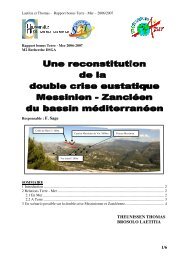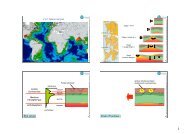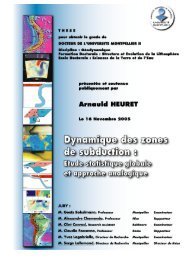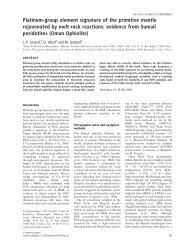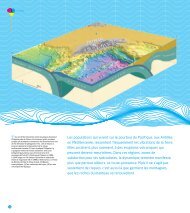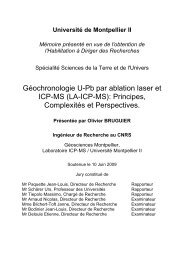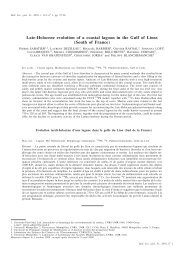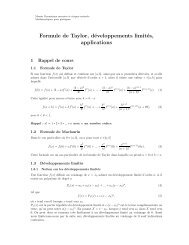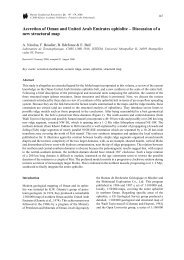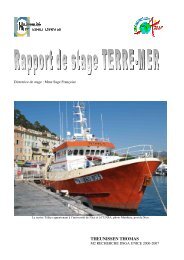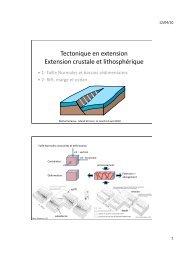B. Henry, J.P. Liégeois, O. Nouar, M.E.M. Derder, B. Bayou, O ...
B. Henry, J.P. Liégeois, O. Nouar, M.E.M. Derder, B. Bayou, O ...
B. Henry, J.P. Liégeois, O. Nouar, M.E.M. Derder, B. Bayou, O ...
Create successful ePaper yourself
Turn your PDF publications into a flip-book with our unique Google optimized e-Paper software.
418 B. <strong>Henry</strong> et al. / Tectonophysics 474 (2009) 417–434<br />
c. 730 Ma, the age of an undeformed granite pluton considered as late<br />
to post-orogenic (Caby and Andreopoulos-Renaud, 1987). Current<br />
research shows that the Eastern Hoggar was actually stabilized later<br />
than the rest of Hoggar, namely at 575–545 Ma, this period including<br />
both the intrusion of granitoids and regional metamorphism (Fezaa<br />
et al., submitted for publication).<br />
A series of batholiths and plutons intruded along the Raghane<br />
shear zone. In the field they are mostly undeformed, the deformation<br />
being localized in narrow shear zones (<strong>Liégeois</strong> et al., 1994). The main<br />
easily visible effect is the elongated shape of the intrusive bodies<br />
parallel to the Raghane shear zone but this is not the case for all<br />
plutons, some of them being roughly circular. Knowing the existence<br />
in the area of granitoids of several ages at 730 Ma, 620–580 Ma and<br />
575–545 Ma (Bertrand et al., 1986; Caby and Andreopoulos-Renaud,<br />
1987; <strong>Liégeois</strong> et al., 1994; Fezaa et al., submitted for publication) and<br />
even 800–820 Ma (<strong>Liégeois</strong> et al., 2005), we undertook a study of the<br />
Anisotropy of Magnetic Susceptibility (AMS — e.g. King, 1966; Hrouda<br />
et al., 1971; <strong>Henry</strong>, 1974; Djouadi and Bouchez, 1992; Archanjo et al.,<br />
1994; Borradaile and Kehlenbeck, 1996; Pignotta and Benn, 1999;<br />
Bouchez, 2000; Tomezzoli et al., 2003; <strong>Henry</strong> et al., 2004; Auréjac<br />
et al., 2004; Kratinová et al., 2007). We applied this structural method<br />
to eight undeformed plutons located along the Raghane shear zone for<br />
a better understanding of their emplacement relative to the<br />
contemporaneous tectonic stress. To reach such a goal requires dating<br />
of some representative plutons, which has been done on three of them<br />
(U–Pb laser ablation ICP-MS on zircon). The studied plutons belonging<br />
to three different stages (c. 790 Ma, c. 590 and c. 550 Ma), the study of<br />
their AMS aims at deciphering the complex interplay of the successive<br />
tectonic stresses registered by nearly strain-free plutons that occurred<br />
along a same mega shear-zone. In addition, this study provides<br />
information about the behavior of the western margin of the Saharan<br />
metacraton during the Neoproterozoic.<br />
2. Geological setting<br />
2.1. The Tuareg shield<br />
The Tuareg shield (Fig. 1) iscomposedof23terranesArchaeanto<br />
Neoproterozoic in age, juxtaposed after large displacements along<br />
mega-shear zones (Black et al., 1994; <strong>Liégeois</strong> et al.,1994). Most of these<br />
Fig. 1. General geological sketch map of the Tuareg shield showing the studied Late Panafrican plutons. Terranes of Assodé (As), Issalane (Is), Tazat (Tz), Aouzegueur (Az), Barghot (Ba),<br />
Djanet (Dj) and Edembo (Ed). Tihaliouine (Tih — <strong>Henry</strong> et al., 2008), Teg Orak (Teg — <strong>Henry</strong> et al., 2008), Tesnou (Tes — Djouadi and Bouchez, 1992), Alous En Tides (AET — <strong>Henry</strong> et al.,<br />
2004), In Telloukh (ITe — <strong>Henry</strong> et al., 2007), Tioueine (To — Djouadi et al., 1997), Tifferkit (Tf — <strong>Henry</strong> et al., 2006) and In Tounine (Ito — <strong>Henry</strong> et al., 2006) plutons. Tadoumet (TA) and<br />
Tiririne (TR) areas.



